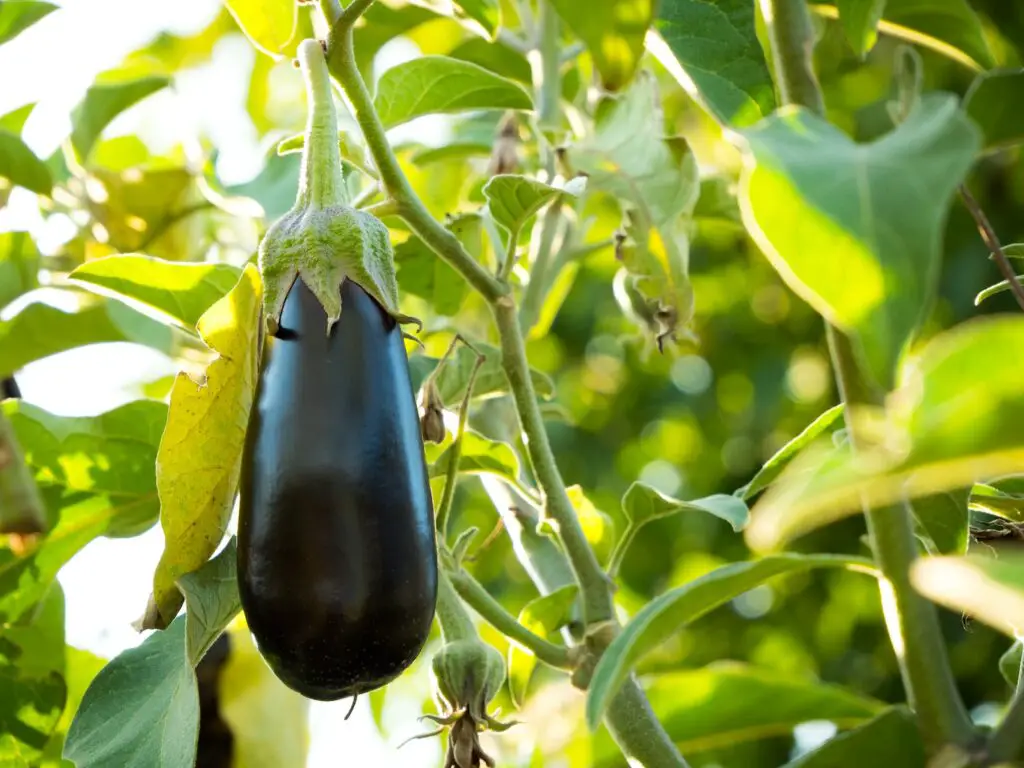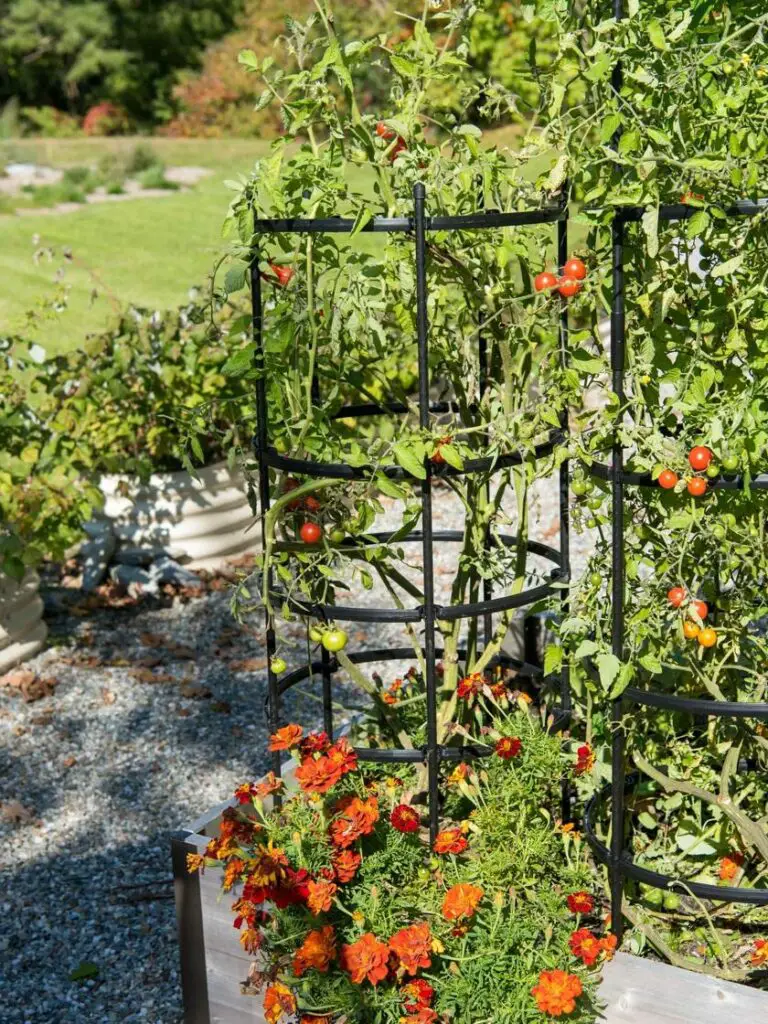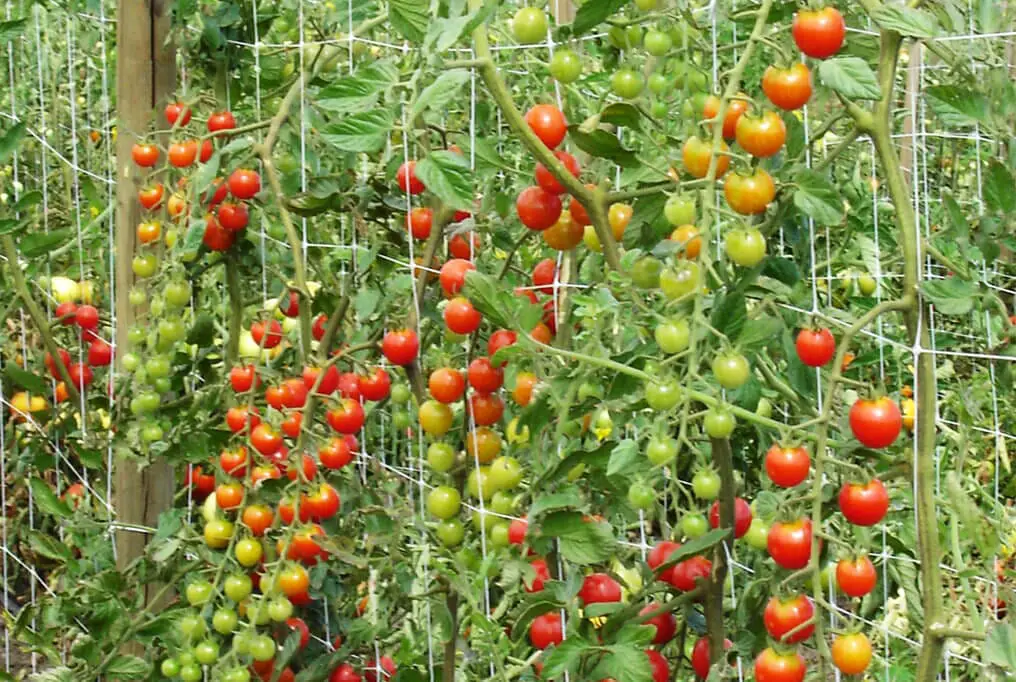
Eggplants are a popular vegetable for gardeners to grow due to their versatility in cooking and their nutritional value. However, many gardeners may wonder if eggplants require a trellis to grow properly.
The answer to whether or not eggplants need a trellis is not a simple one. Eggplants can grow both as a bush and as a vine, depending on the variety, and this can affect whether or not a trellis is necessary. Some bush varieties of eggplants, such as the Black Beauty and the Ichiban, do not require a trellis as they grow low to the ground and do not have long vines. However, other varieties, such as the Rosa Bianca and the Listada de Gandia, are vine-like and benefit from a trellis to support their growth.
Overall, whether or not eggplants need a trellis depends on the specific variety being grown and the gardener’s preference. While a trellis can help support the growth of certain vine-like varieties, it is not necessary for all eggplants. Gardeners should research the specific needs of the variety they plan to grow and make a decision based on that information.
Table of Contents
Why Eggplants Need Support
Eggplants are a popular vegetable in many parts of the world. They are easy to grow and can be harvested in a relatively short amount of time. However, eggplants need support in order to grow properly.
Without support, the plant can become weak and the fruit may not be able to grow to its full size. The stem of the eggplant plant is not strong enough to support the weight of the fruit, especially as it grows larger. This is why it is important to provide support for the plant.
Support can come in many forms, such as a trellis, stakes, or cages. A trellis is a popular option because it allows the plant to grow vertically, which can save space in the garden. Stakes and cages are also effective, but they may take up more space.
Providing support for the eggplant plant can also help with its growth. When the plant has support, it can focus its energy on producing fruit instead of using its energy to keep itself upright. This can result in larger fruit and a higher yield.
In addition, supporting the eggplant plant can also help with the growth of the branches. When the plant is supported, it can grow more branches, which can lead to more fruit. This can also help to increase the overall size of the plant.
Overall, providing support for eggplants is important for the health and growth of the plant. It can help to produce larger fruit and a higher yield, and it can also save space in the garden.
Choosing the Right Trellis for Eggplants
When it comes to growing eggplants, having a trellis is not always necessary, but it can be beneficial. A trellis helps keep the plants upright and off the ground, which can prevent disease and pests. Additionally, trellising can increase yield and make harvesting easier. Here are some trellising options to consider when growing eggplants.
Stake

Staking is a simple and inexpensive trellising option for eggplants. It involves using a sturdy wooden or metal stake and tying the plant to it as it grows. The stake should be at least 4 feet tall and driven firmly into the ground next to the plant. As the plant grows, tie it to the stake with soft twine or plant ties. Staking works well for smaller eggplant varieties or for gardeners with limited space.
Tomato Cage

Tomato cages are another option for trellising eggplants. They are made of wire and come in various sizes. Choose a cage that is at least 4 feet tall and has a diameter of 18 inches or more. Place the cage around the plant and gently guide the stems through the openings. Tomato cages are a good choice for larger eggplant varieties or for gardeners who want a more decorative trellis.
Netting

Netting is a versatile trellising option for eggplants. It can be used to create a vertical trellis or a horizontal trellis. For a vertical trellis, attach the netting to a sturdy frame or fence and tie the eggplant stems to the netting as it grows. For a horizontal trellis, attach the netting to stakes or poles and tie the eggplant stems to the netting. Netting is a good choice for gardeners with limited space or for those who want a trellis that can be easily moved.
When choosing a trellis for eggplants, it is important to select materials that are strong and durable. Wooden stakes should be made of rot-resistant wood, such as cedar or redwood. Metal stakes should be made of rust-resistant metal, such as galvanized steel. Tomato cages should be made of heavy-duty wire that will not bend or break under the weight of the plant. Netting should be made of strong, UV-resistant material that will not tear or fray.
In conclusion, choosing the right trellis for eggplants depends on the gardener’s needs and preferences. Staking, tomato cages, and netting are all viable options for trellising eggplants. When selecting a trellis, be sure to choose materials that are strong and durable to ensure the trellis can support the weight of the plants.
Planting Eggplant with a Trellis
When planting eggplants, trellising is an option that can be considered. A trellis helps to support the plant and allows it to grow vertically, saving space in the garden and making it easier to harvest. Here are some tips on how to plant eggplants with a trellis.
First, choose a location with full sun and well-drained soil. Eggplants prefer a slightly acidic soil with a pH between 5.5 and 6.5. Before planting, amend the soil with compost or other organic matter to improve its fertility and drainage.
When planting, either sow seeds directly in the soil or transplant seedlings. If sowing seeds, plant them ¼ inch deep and 2-3 inches apart in rows that are spaced 24-36 inches apart. If transplanting seedlings, space them 18-24 inches apart in rows that are spaced 24-36 inches apart.
After planting, install a trellis to support the plants. A simple trellis can be made with stakes and twine, or a more elaborate trellis can be purchased. The trellis should be installed when the plants are still small to avoid damaging the roots later on.
As the plants grow, tie them to the trellis with twine or other soft material. This will help to support the plants and keep them from falling over. It is important to keep the plants well-watered and fertilized throughout the growing season.
In conclusion, planting eggplants with a trellis can be a great way to save space in the garden and make harvesting easier. By following these tips, gardeners can successfully grow eggplants on a trellis and enjoy a bountiful harvest.
Maintaining Eggplant Growth on a Trellis
When growing eggplants on a trellis, it is important to maintain their growth to ensure a healthy and productive harvest. Here are some tips for maintaining eggplant growth on a trellis:
Watering and Moisture Management
Eggplants require consistent moisture to thrive. Watering should be done deeply and consistently to ensure that the plants receive enough water. It is important to avoid watering too much or too little, as this can lead to problems with disease and yield.
To ensure consistent moisture, a soaker hose can be used to water the plants. This will help to avoid overwatering and ensure that the water is distributed evenly to the roots.
Fertilizing and Soil Health
Eggplants require well-drained soil that is rich in organic matter. Fertilizing can help to improve soil health and provide the nutrients that the plants need to grow. A balanced fertilizer can be used to provide the necessary nutrients to the plants.
It is important to avoid over-fertilizing, as this can lead to problems with growth and yield. A soil test can be done to determine the nutrient levels in the soil and help to determine the appropriate amount of fertilizer to use.
Pruning and Air Circulation
Pruning is an important part of maintaining eggplant growth on a trellis. It helps to promote air circulation and prevent disease. Pruning should be done regularly to remove any damaged or diseased leaves and to promote new growth.
Air circulation is also important for maintaining eggplant growth on a trellis. It helps to prevent problems with disease and promote healthy growth. The trellis should be placed in a location that receives adequate air circulation, and the plants should be spaced out to allow for proper airflow.
By following these tips, gardeners can maintain healthy eggplant growth on a trellis and enjoy a productive harvest.
Common Diseases and Pests
Eggplants are susceptible to a variety of diseases and pests that can damage or kill the plants. Here are some of the most common issues to watch out for:
Diseases
- Verticillium Wilt: This soil-borne disease can cause yellowing and wilting of the leaves, as well as stunted growth and reduced fruit production. It is caused by a fungus that infects the roots and stems of the plant.
- Phytophthora Blight: This fungal disease can cause blackened areas on the stems, leaves, and fruit of the eggplant. It can also cause the plant to wilt and die.
- Bacterial Wilt: This disease is caused by a bacterium that infects the plant’s vascular system, causing it to wilt and die.
- Fusarium Wilt: This soil-borne disease can cause wilting and yellowing of the leaves, as well as stunted growth and reduced fruit production.
Pests
- Flea Beetles: These small, black beetles can cause small holes in the leaves of the plant, which can lead to stunted growth and reduced fruit production.
- Aphids: These small, soft-bodied insects can suck the sap from the leaves of the plant, causing them to yellow and wilt. They can also transmit plant viruses.
- Spider Mites: These tiny insects can cause yellowing and bronzing of the leaves, as well as stunted growth and reduced fruit production.
- Cutworms: These caterpillars can cut off the stem of the plant at ground level, causing it to wilt and die.
To prevent these issues, it is important to keep the plants healthy and well-maintained. This includes proper watering, fertilization, and pruning. It is also a good idea to rotate crops and practice good sanitation to prevent the spread of disease.
Harvesting Eggplant from a Trellis
When eggplants are grown on a trellis, harvesting can be easier and more efficient. The fruit is typically larger and more abundant when grown vertically, as the trellis allows for better air circulation and sunlight exposure.
To harvest eggplants from a trellis, start by checking the fruit for ripeness. Mature eggplants should be firm and glossy, with a deep, rich color. If the fruit is dull or soft, it may be overripe or past its prime.
To remove the fruit from the trellis, gently grasp the stem and twist it until it separates from the plant. Avoid pulling or tugging on the fruit, as this can damage the stem and reduce yields.
Once the eggplants are harvested, they can be used in a variety of recipes, from classic dishes like eggplant parmesan to more modern creations like grilled eggplant sandwiches. With proper care and attention, a trellis-grown eggplant plant can produce abundant and delicious fruit throughout the growing season.
Different Varieties of Eggplant and Their Trellising Needs
Mediterranean Varieties
Mediterranean eggplants, also known as aubergines, are the most common type of eggplant. They are typically large and round with a dark purple color. These varieties prefer warm climates and full sun exposure. They can grow up to 4 feet tall and require sturdy trellising support to prevent the heavy fruit from breaking the stem.
Some popular Mediterranean varieties include:
- Black Beauty: A classic variety with a glossy, dark purple skin and round fruit shape.
- Rosa Bianca: A beautiful variety with a pink and white striped skin and a round fruit shape.
- Long Purple: A long and slender variety with a dark purple skin and an elongated fruit shape.
Asian Varieties
Asian eggplants are smaller and more slender than Mediterranean varieties. They come in a range of colors, including purple, green, and white. These varieties prefer a warm and humid climate with partial sun exposure. They can grow up to 3 feet tall and require a trellis or stake for support.
Some popular Asian varieties include:
- Japanese: A small and slender variety with a dark purple skin and an elongated fruit shape.
- Chinese: A long and slender variety with a green or white skin and an elongated fruit shape.
- Indian: A small and round variety with a green or white skin and a round fruit shape.
Italian Varieties
Italian eggplants are similar to Mediterranean varieties but are typically smaller and more elongated. They come in a range of colors, including purple, green, and white. These varieties prefer warm and dry climates with full sun exposure. They can grow up to 3 feet tall and require trellising support to prevent the heavy fruit from breaking the stem.
Some popular Italian varieties include:
- Rosa Bianca: A beautiful variety with a pink and white striped skin and an elongated fruit shape.
- Listada de Gandia: A colorful variety with a purple and white striped skin and an elongated fruit shape.
- Violetta di Firenze: A deep purple variety with an elongated fruit shape.
In conclusion, different varieties of eggplant have different trellising needs based on their size, shape, and climate preferences. It is important to choose the right trellising support for your eggplant cultivar to ensure healthy growth and a bountiful harvest.
How to Grow Perfect Eggplants Every Time
Frequently Asked Questions
Many gardeners have questions about how to support their eggplant plants. Here are some frequently asked questions about staking and trellising eggplants:
Does eggplant need support?
Yes, eggplant plants need support to keep their heavy fruit off the ground. Without support, the fruit can become damaged and the plant can become diseased.
Can I stake eggplant plants?
Yes, staking is a common way to support eggplant plants. You can use bamboo stakes or other sturdy materials to support the plant stem and keep it from bending or breaking under the weight of the fruit.
How do I stake eggplant plants?
To stake an eggplant plant, drive a stake into the ground next to the plant and tie the stem to the stake with a soft material like twine or cloth. As the plant grows, you may need to add more stakes or adjust the ties to keep the stem upright.
Can I use a trellis for eggplant?
Yes, a trellis can be an effective way to support eggplant plants. A trellis provides more surface area for the plant to grow and can help keep the fruit off the ground.
What kind of trellis should I use for eggplant?
There are many types of trellises that can work for eggplant, including wire mesh, wooden frames, and string trellises. The important thing is to make sure the trellis is sturdy enough to support the weight of the plant and fruit.
Do I need to prune my eggplant plants if I use a trellis?
No, pruning is not necessary if you use a trellis to support your eggplant plants. However, you may want to remove any side shoots that grow below the trellis to keep the plant from becoming too bushy.
How tall should my eggplant trellis be?
Your eggplant trellis should be at least 4 feet tall to accommodate the height of the plant and the weight of the fruit. If you have a particularly large variety of eggplant, you may need to make the trellis taller.
Final Thoughts
In conclusion, eggplants can benefit from a trellis, but it is not always necessary. Gardeners who have limited space may find that growing eggplants without a trellis is a viable option. However, those who have ample space and want to maximize their yield may prefer to use a trellis.
Maintenance is another factor to consider when deciding whether or not to use a trellis. While a trellis can help keep the plant upright and prevent damage from heavy fruit, it also requires regular pruning and training. Gardeners who are willing to put in the extra effort may find that a trellis is worth the investment.
While eggplants are not typically grown for their flowers, they do produce attractive purple blooms that can add visual interest to a garden. Additionally, eggplants are a versatile vegetable that can be used in a variety of dishes, making them a popular choice among home gardeners.
Overall, whether or not to use a trellis for eggplants depends on a variety of factors, including space, maintenance, and personal preference. While a trellis can help increase yield and prevent damage, it is not always necessary. As a tender perennial, eggplants require some care and attention, but with proper care, they can be a rewarding addition to any garden.